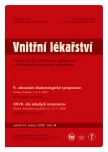Mucosal immunity with emphasise on urinary tract immunity and diabetes
Authors:
J. Krejsek; M. Kudlová; M. Koláčková; J. Novosad
Authors‘ workplace:
Ústav klinické imunologie a alergologie Lékařské fakulty UK a FN Hradec Králové, přednosta prof. RNDr. Jan Krejsek, CSc.
Published in:
Vnitř Lék 2008; 54(5): 478-481
Category:
Předneseno na 9. celostátním diabetologickém sympoziu „Diabetes a urogenitální systém“ ve dnech 1.-2. června 2007 v Novém Adalbertinu v Hradci Králové
Overview
Protective immune response in urinary tract is frequently impaired in patients with diabetes. Immunity in this mucosal compartment displays unique characteristics; e.g. absence of physiological microflora and lack of mucus. Pathogens are identified by the PRR receptors expressed on both epithelial and immune cells. Inflammatory response characterised by the acumulation of granulocytes is followed. Both protective and harm characteristics of inflammatory response are inseparable linked and delineated by gene polymorphisms in PRR receptors.
Key words:
diabetes mellitus - mucosal immunity - urinary tract - infection
Sources
1. Peleg AY, Weerarathna T, McCarthy JS et al. Common infections in diabetes: pathogenesis, management and relationship to glycaemic control. Diabetes Metab Res Rev 2007; 23: 3-13.
2. Eckmann L. Defence molecules in intestinal innate immunity against bacterial infections. Curr Opin Gastroenterol 2005; 21: 147-151.
3. Takeda K, Akira S. Toll-like receptors in innate immunity. Int Immunol 2005; 17: 1-14.
4. Lin L. RAGE on the toll road? Cell Mol Immunol 2006; 3: 351-358.
5. Säemann MD, Weichhart T, Hörl WH et al. Tamm-Horsfall protein: a multilayered defence molecule against urinary tract infection. Eur J Clin Invest 2005; 35: 227-235.
6. Pickup JC. Inflammation and activated innate immunity in the pathogenesis of type 2 diabetes. Diabetes Care 2004; 27: 813-823.
7. Svanborg C, Bergsten G, Fischer H et al. Uropathogenic Escherichia coli as a model of host-parasite interaction. Curr Opin Microbiol 2006; 9: 33-39.
8. Zhang D, Zhang G, Hayden MS et al. A toll-like receptor that prevents infection by uropathogenic bacteria. Science 2004; 303: 1522-1526.
9. Karoly E, Fekete A, Banki NF et al. Heat shock protein 72 (HSPA1B) gene polymorphism and toll-like receptor (TLR) 4 mutation are associated with increased risk of urinary tract infection in children. Pediatr Res 2007; 61: 371-374.
10. Sirard JC, Bayardo M, Didierlaurent A. Pathogen-specific TLR signaling in mucosa: mutual contribution of microbial TLR agonists and virulence factors. Eur J Immunol 2006; 36: 260-263.
Labels
Diabetology Endocrinology Internal medicineArticle was published in
Internal Medicine

2008 Issue 5
Most read in this issue
- Metformin and kidneys
- Haemocoagulation and renal insufficiency, haemocoagulation and type 2 diabetes mellitus
- Specific issues of dialysed diabetics in outpatient practice
- Examination of the kidneys in a diabetic patient
